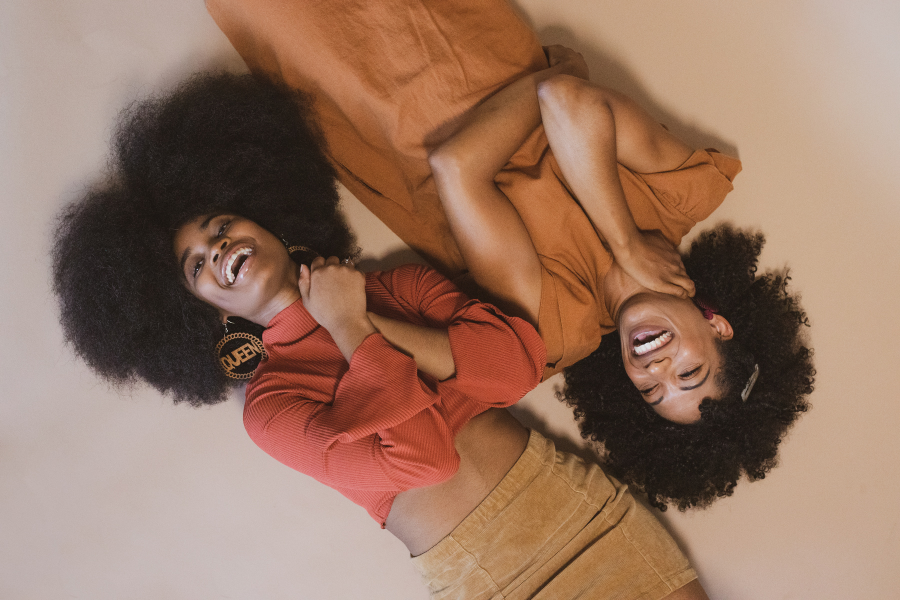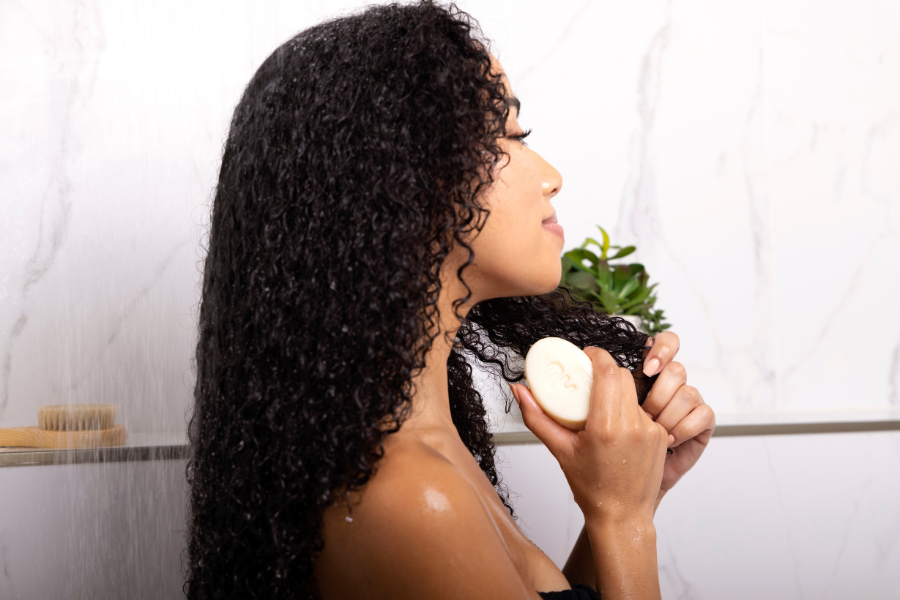Crave healthier hair? Here is the ultimate guide to achieving the look you deserve

Does it feel like you shed more than average every time you take a shower? After at-home styling, do you notice broken hair strands along the bathroom counter? Are mental, physical, and environmental stressors interfering with your hair goals?
Our crowns are a great source of pride, and a bad hair day can ruin the way we feel about ourselves and negatively impact our productivity as we conquer the world. So, if you have ever experienced any of the above, this healthy hair guide is for you, Queen. You always deserve to look and feel your best. You deserve it all.
So, let’s talk about quantity. How much hair are we supposed to have?
The hair on our heads is composed of two parts: the shaft (the dead part that we see) and the follicle (the living root of the hair below the scalp that we don’t see). The average human is born with around 100,000 hair follicles to grow hair from, and shedding 50-100 hairs a day is considered normal. But while you can grow new hair, you can’t develop new follicles. So what you have is all you’ve got.

There are four phases of hair growth: the anagen phase (period of active growth), the catagen phase (the period when hair detaches from the blood vessels but stays connected to the follicle), the telogen phase (period of rest), and the exogen phase (or anagen restart when hair sheds and new hair starts to grow).
In a healthy human, 85-90% of the hair is in the anagen phase or the growth period. Most supplements like these aim to extend the anagen phase for as long as possible to reduce hair loss (up to 8 years), but on average, this period lasts 4-6 years. The other phases of growth last only a few weeks or months.
Typically, 1% of the hair is in the catagen phase, where the follicles shrink and detach the hair from its blood supply. It stops growing at this stage due to a lack of nutrients. The remainder of the hair is in the telogen phase of growth, where it is resting and preparing to shed in the exogen phase. Did you know stress can push the hair into catagen phase prematurely? (Check out this blog to learn more)
Now, let’s talk about quality. Much like our skin, our hair directly reflects internal health. As with so many other processes in the body, hair requires a certain amount of nutrients to stay strong, hydrated, and healthy.
Hair health is determined by genetics, diet, and routine maintenance. But, of course, we can’t control genetics, so let’s focus on what we can control: diet and routine maintenance.
While genes control the texture of your hair, much of what determines the strength, length, and health of your hair happens in the hair follicles. Our hair relies on our blood vessels within the follicles to provide it with all the necessary nutrients. And while levels of nutrients and trace minerals tend to vary with factors like age and genetics, diet and stress levels play a significant role in the overall health of your hair.
So, let’s talk nourishment, Queens...
So, what constitutes a strand of hair? Protein, water, and minerals.
A typical strand of hair consists of mostly keratin (protein), but it also contains water and some trace minerals, including magnesium, selenium, calcium, iron, zinc, and copper.
Suppose we aren’t getting enough protein, enough water, or enough minerals? In that case, our hair will communicate this through premature shedding, breakage, and a dry, brittle appearance.
So how do we make sure our crowns get the love and nourishment they deserve? Being proactive and ensuring we take in the protein, water, and nutrients we need to grow strong, healthy hair. What nutrients are those?
Vitamin A plays a role in cell growth (including ALL the cells in your body). It also helps the sebaceous glands produce sebum, an oily substance that moisturizes and protects our hair. However, too much vitamin A in the body can have adverse effects and cause hair loss.
(foods rich in vitamin A: liver, mackerel, salmon, tuna, cheese, eggs)
B-Vitamins help the body produce the red blood cells that provide nutrients to the hair follicles. So they essentially help provide nutrients to the whole body. There are a few different ones: thiamine (B1), riboflavin (B2), niacin (B3), pantothenic acid (B5), pyridoxine (B6), biotin (B7), folate (B9), and cobalamin (B12). Deficiencies in riboflavin (B2), biotin (B7), folate (B9), and cobalamin (B12) can cause hair loss.
(foods rich in B vitamins: salmon, leafy greens, liver, eggs, milk, beef, oysters, clams, mussels, legumes, poultry, pork, yogurt, nutritional yeast, trout, fortified cereal)
Vitamin C gets a lot of publicity for its immune-boosting and antioxidant properties. We love it for hair because it also helps the body make collagen (which contains the building blocks for keratin, an essential protein). Vitamin C also improves our body’s iron absorption.
(foods rich in vitamin C: fruits and vegetables)
While its relationship to hair growth is still somewhat unknown, studies show that vitamin D deficiencies may play a role in hair loss. Low vitamin D levels appeared in patients with Alopecia Areata, female pattern hair loss, and Telogen Effluvium (stress, drug, or hormone-related hair loss). The lower the levels, the more severe the case. Vitamin D helps the body absorb calcium. It also helps lower stress hormones in the body that can trigger premature hair fall.
(foods rich in vitamin D: fish, egg yolks, mushrooms, fortified foods)
Vitamin E improves scalp health by increasing blood flow to the hair follicles and protecting the hair and scalp against oxidative stress due to its antioxidant properties. We get our antioxidants from vitamin E, vitamin C, and selenium in our diets. Examples of prooxidants include pollution, UV rays, cigarette smoke, and poor diet. When prooxidants outweigh antioxidants, the result is oxidative stress. This imbalance between antioxidants and prooxidants in the body can lead to premature hair loss.
(foods rich in vitamin E: nuts, nut oils, salmon, avocado, trout, red peppers, mango, kiwi, turnip greens)
Iron helps hemoglobin (a protein in our red blood cells) carry oxygen to the tissues in the body. Do you ever feel out of breath without an intense workout or experience unexplained, extreme fatigue? It could be a sign of an iron deficiency, as your tissues could not receive the oxygen they needed at that moment. The same goes for hair. The scalp needs hemoglobin to carry oxygen to the follicles for hair growth. Studies show that people suffering from hair loss tend to have lower iron levels than those not experiencing hair loss. Thankfully, hair loss related to an iron deficiency does not cause permanent damage to the follicle. With a proper diet, hair can grow back.
(foods rich in iron: shellfish, spinach, liver, legumes, red meat, pumpkin seeds, quinoa, turkey, broccoli, dark chocolate, tofu, fish)
Zinc is an essential mineral that our body does not produce independently. We consume this mineral through our diet to help boost immune function, cell growth and wound healing. Studies have shown a link between zinc deficiency and hair loss. Studies have also shown that a zinc overdose can cause hair loss. But how? Elevated zinc levels can suppress your body’s ability to absorb copper, and a copper deficiency can cause breakage and follicle damage.
(foods rich in zinc: red meat, shellfish, legumes, nuts, seeds, dairy, eggs, whole grains)
Hair contains lots of calcium, so a calcium deficiency will ultimately affect the structure of your hair. Like how calcium is associated with strong bones, it is also associated with strong, healthy hair. Interestingly, vitamin D and magnesium intake helps to determine calcium levels more than calcium intake alone. Scientists believe that vitamin D and magnesium work together to help the body absorb calcium.
(foods rich in calcium: seeds, cheese, yogurt, sardines, canned salmon (because of the edible bones), dark leafy greens, nuts, beans & lentils, milk, whey protein)
Magnesium is responsible for cell production, cell division, and cell growth. Cells will die off with a severe magnesium deficiency, and hair will stop growing and eventually fall out. Magnesium also works with other minerals in the body to maintain overall health and well-being. Unfortunately, in the United States, close to half of the population takes in less than the estimated average magnesium requirement, based on dietary surveys.
(foods rich in magnesium: dark chocolate, avocado, nuts, seeds, legumes, tofu, whole grains, fatty fish, bananas, leafy greens)
Selenium plays an essential role in reproduction, thyroid hormone metabolism, DNA synthesis, and protection from oxidative damage and infection. Most Americans get the selenium they need through diet, but a deficiency can cause hair loss and premature graying. Conversely, too much selenium in the body can also cause hair loss.
(foods rich in selenium: Brazil nuts, fish, pork, beef, turkey, chicken, cottage cheese, eggs, sunflower seeds, baked beans, mushrooms, spinach, oatmeal, milk and yogurt, brown rice)
Copper is an essential mineral for the strength of your hair as it plays a role in tissue formation and repair. While copper deficiency is rare since the body only needs small amounts, it is usually not a problem of intake but instead of absorption. If your body is struggling to absorb the copper in your diet, you may notice brittle hair, breakage, and premature graying. Copper toxicity is possible if you consume too much, so supplementing is not recommended without consulting a physician.
(foods rich in copper: liver, oysters, spirulina, shiitake mushrooms, nuts, seeds, lobster, leafy greens, dark chocolate)
Our bodies contain loads of silicon in our skin, nails, and hair. This trace element is responsible for skin elasticity, nail strength, and reduced hair loss. It also improves hair growth. Silicon is also present in many foods we eat. However, scientists are still researching whether or not the consumption of silicon affects the amount of silicon present in our bodies. In addition, there is mixed information about how much of this element we can absorb through digestion.
(foods rich in silicon: whole grains, fruits, some drinking water, vegetables)
So to recap, to grow and maintain healthy hair, the body needs lots of protein, lots of water, and LOTS of vitamins and minerals. Supplementing is essential for correcting nutritional deficiencies, but taking your daily hair vitamin should not substitute for a healthy diet.
We recommend a diet loaded with seasonal local fruits, vegetables, sustainable seafood and meats, poultry, beans, nuts, seeds, high fiber whole grains, and full-fat dairy products. A low-fat diet decreases hair hydration and can cause hair loss. The less you consume from this list of food groups, the more you will need to supplement. Avoid processed food, excess sugar, and alcohol.
It is important to note that consuming specific vitamins and minerals in excess can have adverse effects on the health of your hair. For example, overdoses of any of the following can cause hair loss: selenium, vitamin A, and zinc. And if anything feels off, talk to your doctor, as they can best diagnose any overdoses or deficiencies.
Staying hydrated, consuming a healthy diet, and supplementing as needed are great ways to improve the overall health of your hair and prevent hair loss.
But you know what also helps? EXERCISE.
It is so important to get your blood flowing. This is because your scalp receives nutrients from your blood, and the more blood that reaches your scalp and hair follicles, the more nutrients your hair will receive.
Increased blood circulation is excellent for the whole Queen, not just her crown. In addition, an active lifestyle decreases your risk of many health complications, including stress-induced hair loss.
While diet and supplements can help you reduce shedding to grow longer, stronger, healthier hair from the inside, how do you treat and prevent damage from external physical stressors? Sounds like a job for your trusted hairstylist.
If you love to color your hair or use relaxers, we recommend receiving a bond-building treatment from your stylist to treat and prevent damage. And bond-building treatments are not exclusive to Queens undergoing chemical processes. Virgin, textured hair can also benefit from reconstruction and repair as it is incredibly delicate and more prone to breakage.
Chemical treatments to color or loosen your hair texture can leave the hair feeling dry and brittle. This bond-building treatment will help to re-hydrate the hair, seal the cuticle to prevent breakage, and give your hair a shinier and healthier feel. Clients of the process also report increased manageability.
Over time, the ends of your hair will eventually split and continue to split up the entire hair shaft. To avoid cutting off inches of hair every time you see your stylist, trimming every 4-8 weeks will help keep the ends of your hair in check.
Hairstylists are also known for giving fantastic scalp massages. These massages help boost circulation to the follicles to promote hair growth, and according to anecdotal information, they are super relaxing, which every Queen deserves, so treat yourself.
Now that you know how to nourish your hair and treat and prevent damage, let’s talk about routine care. For instance, did you know environmental stress can lead to premature breakage?
We love going outside and soaking up the sun, but UV rays, pollutants, hard water, chlorine, and hot temperatures can cause stress to your hair shaft and ultimately lead to breakage and increased shedding if you aren’t careful.
For more day-to-day protection, rotate hairstyles to ensure no one part of your hair receives too much stress. That means regularly alternating the parts in your hair, rotating between high buns and low buns, wearing your hair out sometimes, and using braids or twists as a protective style.
The less time you spend styling and manipulating your hair, the more likely it is to stay healthy. Traction alopecia, for instance, results from repeatedly pulling the hair too tight. And breakage can result from excess manipulation.
Routine maintenance also includes washing your hair, which we recommend doing at least 1-2 times a week. Ideally, you will shampoo your hair every four days to avoid product build-up and keep your scalp healthy. Our scalp’s natural oil, sebum, can attract dirt, debris, and microscopic bugs that you do not want in your life.
We recommend conditioning your hair after shampooing to lay down the cuticle, promote shine, and improve manageability. If you use our HYDRATE N GO Butter Bars to condition, don't fully rinse the product for added shine and hydration throughout the day.
 Repeated heat styling can cause damage to your hair over time. Unfortunately, textured hair is exceptionally delicate, and every curl/curve marks a weak spot that is prone to breakage.
Repeated heat styling can cause damage to your hair over time. Unfortunately, textured hair is exceptionally delicate, and every curl/curve marks a weak spot that is prone to breakage.
To protect your hair while wearing your textured hair straight, we recommend using a hair serum and rubbing less than a dime-sized amount throughout the hair and ends before heat styling. This step will create a barrier between your hair and the heating tool to prevent damage. Also, avoid applying heat to oily hair as it can cause damage and breakage.
This may seem like overwhelming information, so let’s break it down into three easy steps. First, for healthy hair, you will need to nourish your body. Next, find a stylist to treat and prevent hair damage, and finally, care for your hair using products that seal the cuticle, improve manageability, and protect your hair from heat or environmental stressors.
For an easier and better hair care journey, nourish your scalp with our Take N Go™ Daily Hair Vitamins, a blend of over 25 ingredients specifically targeting hair health for reduced shedding.
Two vitamins per day are all you need to compensate for common deficiencies in the average busy Queen on the go. Our vitamins are designed to complement your healthy lifestyle while reducing stress and risk of illness, promoting overall wellness, supporting healthy hair growth, and reducing hair loss.
Periodically treat your hair with a Hydrasilk™ treatment from your hairstylist for optimal length retention and to prevent damage from physical stress. And finally, give your tresses the routine maintenance they deserve. Care for your hair using our Go Series™ maintenance products for the Busy Queen on the go to reduce any potential damage from environmental stressors. We hope this guide will help you achieve your ultimate hair goals because you deserve to look and feel your best. You deserve it all.
SOURCES:
https://www.ncbi.nlm.nih.gov/pmc/articles/PMC4201279/
https://www.intechopen.com/books/hair-and-scalp-disorders/anatomy-and-physiology-of-hair
https://www.ncbi.nlm.nih.gov/pmc/articles/PMC3241917/
https://www.sciencedirect.com/science/article/pii/S0022202X15477115
https://www.healthline.com/nutrition/best-vitamins-hair-growth#_noHeaderPrefixedContent
https://www.ncbi.nlm.nih.gov/pmc/articles/PMC3237781/
https://emedicine.medscape.com/article/835470-overview
https://www.healthline.com/health/beauty-skin-care/vitamin-e-for-hair#_noHeaderPrefixedContent
https://www.ncbi.nlm.nih.gov/pmc/articles/PMC4387693/
https://www.mayoclinic.org/drugs-supplements-vitamin-a/art-20365945
https://www.ncbi.nlm.nih.gov/pmc/articles/PMC5751255/
https://www.jaad.org/article/S0190-9622(05)04745-6/fulltext
https://www.medicalnewstoday.com/articles/321668
https://ods.od.nih.gov/factsheets/Zinc-Consumer/
https://www.ncbi.nlm.nih.gov/pmc/articles/PMC4828511/
https://www.ncbi.nlm.nih.gov/pmc/articles/PMC3241915/
https://ods.od.nih.gov/factsheets/Selenium-HealthProfessional/
https://www.ncbi.nlm.nih.gov/pmc/articles/PMC3250020/
https://www.ncbi.nlm.nih.gov/pmc/articles/PMC3870206/
https://ods.od.nih.gov/factsheets/Copper-Consumer/
https://www.ncbi.nlm.nih.gov/pmc/articles/PMC6380979/
https://www.healthline.com/nutrition/foods-high-in-vitamin-a
https://www.healthline.com/nutrition/vitamin-b-foods
https://www.healthline.com/nutrition/vitamin-c-foods
https://www.healthline.com/nutrition/9-foods-high-in-vitamin-d
https://www.healthline.com/nutrition/foods-high-in-vitamin-e
https://www.healthline.com/nutrition/healthy-iron-rich-foods
https://www.healthline.com/nutrition/best-foods-high-in-zinc
https://www.healthline.com/nutrition/15-calcium-rich-foods
https://www.healthline.com/nutrition/10-foods-high-in-magnesium
https://www.healthline.com/health/selenium-foods
https://www.healthline.com/nutrition/foods-high-in-copper
https://www.hindawi.com/journals/ije/2013/316783/



